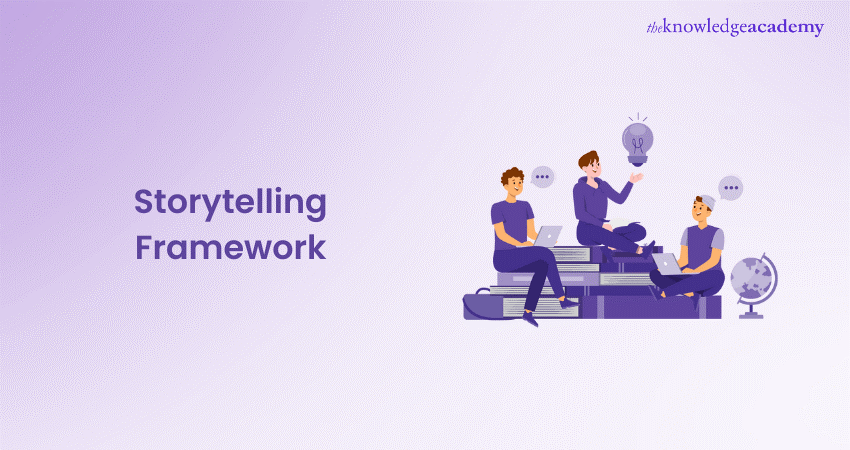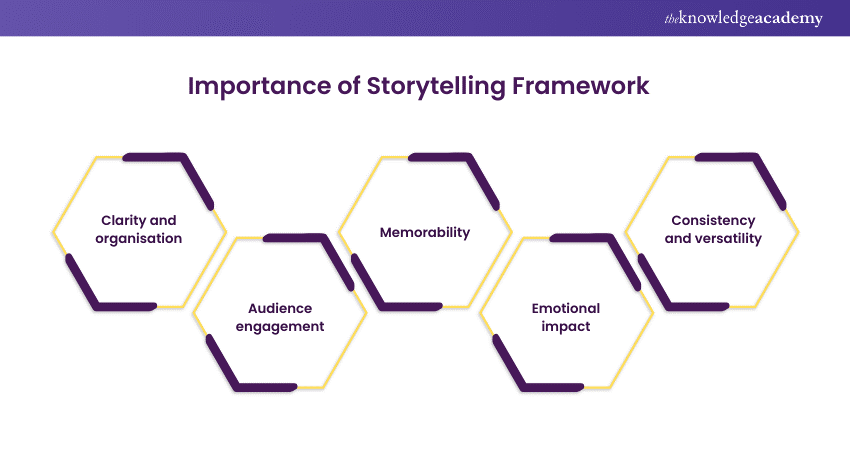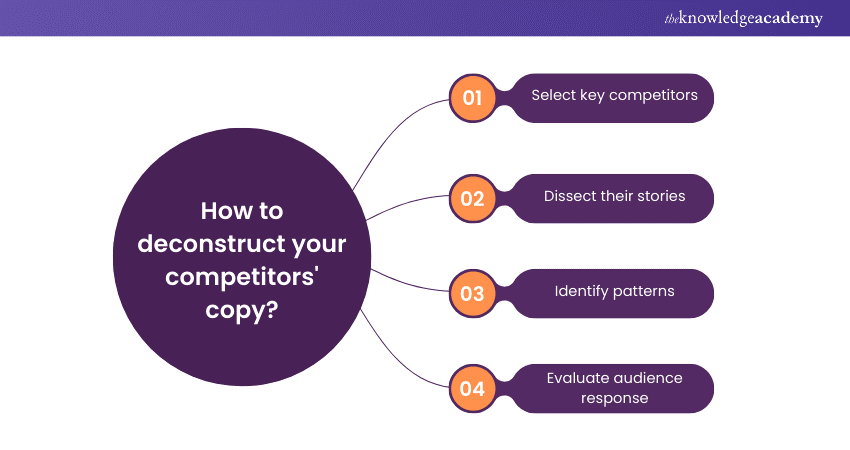We may not have the course you’re looking for. If you enquire or give us a call on +1 6474932992 and speak to our training experts, we may still be able to help with your training requirements.
Training Outcomes Within Your Budget!
We ensure quality, budget-alignment, and timely delivery by our expert instructors.

When it comes to communication in today's fast-paced world, grabbing and retaining attention is a daunting challenge. The consequences of failing to engage your audience can lead to missed opportunities and ineffective messaging. However, understanding Storytelling Frameworks can help you break through the noise, connect with your audience, and convey your message effectively.
Thus, learning more about these Frameworks can help you better connect with your audience if you are a storyteller, writer, or speaker. So, read this blog to learn what a Storytelling Framework is and why it should be used, along with some successful frameworks for Storytelling. Let's dive in!
Table of Contents
1) What is a Storytelling Framework?
2) Why use a Storytelling Framework?
3) Four successful Storytelling Frameworks
4) The Benjamin Franklin method
5) Conclusion
What is a Storytelling Framework?
A Storytelling Framework is a systematic and structured approach used to create compelling narratives. It serves as a blueprint for crafting stories that captivate and resonate with the audience. This Framework typically includes essential elements like characters, plot, conflict, and resolution, which are carefully arranged to create a coherent and engaging story.
Why use a Storytelling Framework?
Storytelling is a timeless and universal form of communication that has been an integral part of human culture for centuries. However, to harness its full potential, storytellers often employ a structured Framework. Here's a more detailed look at why using a Storytelling Framework is essential:

a) Clarity and organisation: A Storytelling Framework provides a clear and organised structure for your narrative. It guides you in arranging your thoughts and ideas in a coherent sequence. By having a well-defined beginning, middle, and end, your story becomes easier to follow and understand.
b) Audience engagement: These Frameworks are designed to capture and maintain your audience's attention. They include elements that pique curiosity, create suspense, and invoke emotional connections. As a result, your audience will stay highly engaged throughout your story.
c) Memorability: Structured narratives tend to be more memorable. The human brain is wired to retain information presented in a structured and sequential manner. When you use a Storytelling Framework, your message becomes more enduring and leaves a lasting impression on your audience.
d) Emotional impact: Frameworks often incorporate elements like character development, conflict, and resolution, which are crucial for evoking emotions in your audience. When your story resonates emotionally, it becomes more impactful and relatable.
e) Consistency and versatility: Whether you're a marketer, writer, speaker, or communicator, a Storytelling Framework ensures consistency in your messaging. It allows you to adapt your story to different platforms, audiences, and contexts while maintaining the core narrative structure.
Overall, a Storytelling Framework is a powerful tool that provides storytellers with the means to convey their messages effectively. It elevates Storytelling from a random assortment of anecdotes to a well-crafted, purposeful narrative that can entertain, educate, inspire, and connect with audiences on a deeper level.
Become a sales expert! Join our Sales Training to refine your skills and reach your goals!
Four successful Storytelling Frameworks
In the world of Storytelling, there are various Frameworks that have proven to be highly successful in creating captivating narratives. These Frameworks offer a blueprint for crafting stories that resonate with audiences across different mediums. Let's explore four of the most renowned Storytelling Frameworks:
The Pixar Storytelling Framework
Pixar, the renowned animation studio, has mastered the art of Storytelling. Their Framework consists of the following six key elements:
1) Once upon a time: Introduce the main characters and the setting.
2) Every day, until one day: Establish the normalcy of the characters' lives.
3) Because of that: Introduce an event that disrupts the status quo.
4) Because of that: Describe the consequences and actions taken.
5) Until finally: Highlight the climax and resolution of the story.
6) And ever since then: Conclude by showing the long-term effects of the story's events.
This Framework ensures a clear beginning, middle, and end, making Pixar's stories universally appealing.
Join our Sales Management Training. Take your leadership skills to the next level. Register now!
The Hero's Journey Framework
Popularised by Joseph Campbell, the Hero's Journey is a timeless Storytelling Framework that revolves around a hero's adventure. It includes the following stages:
1) The call to adventure
2) Refusal of the call
3) Meeting the mentor
4) Crossing the threshold
5) Return with the elixir
This Framework resonates with audiences because it mirrors the hero's transformation and growth. For example, The Lion King and The Lord of the Rings.
The Rags-to-Riches Storytelling Framework
The Rags-to-Riches Framework centres around a character starting from humble beginnings, facing adversity, and ultimately achieving remarkable success. Audiences are drawn to these stories because they tap into the universal desire for upward mobility and personal growth.
The Big Idea Storytelling Framework
The Big Idea Framework focuses on conveying a central concept or idea. It is commonly used in non-fiction Storytelling, particularly in business and self-help literature. This Framework involves presenting the “Big Idea”, supporting it with anecdotes and evidence, and continually reinforcing the message throughout the narrative. It aims to inspire, educate, and leave a lasting impression on the audience.
Each of these Storytelling Frameworks offers a unique approach to crafting narratives that captivate and engage audiences. The choice of Framework varies on your specific message, audience, and Storytelling goals, allowing you to tailor your stories for maximum impact and resonance.
Elevate your marketing with our Storytelling for Marketers Training - sign up now!
The Benjamin Franklin method
The Benjamin Franklin method is a powerful approach to elevate your Storytelling skills. Named after the renowned polymath and founding father, this method involves a systematic process to analyse and refine your Storytelling Framework. Let's delve into the steps:
Step 1: Deconstruct your competitors' copy
The first step in the Benjamin Franklin method is to thoroughly analyse successful stories within your niche or industry. This analysis entails breaking down the Storytelling structure, character development, and emotional appeal used by your competitors. Here's how to go about it:

a) Select key competitors: Identify prominent storytellers or brands in your field whose narratives resonate with your target audience.
b) Dissect their stories: Scrutinise their content, dissecting it into its core components. Pay attention to elements such as the introduction, character development, conflict, climax, and resolution.
c) Identify patterns: Look for recurring patterns and techniques employed in these narratives. Also, note how they engage emotions, build tension, and connect with the audience.
d) Evaluate audience response: Consider the audience's response to these stories. Analyse comments, shares, and feedback to gauge what resonates with your target audience.
By deconstructing your competitors' successful stories, you gain valuable insights into what captivates and engages your audience within your specific domain.
Step 2: Analyse your revised version alongside the original
The next step is to apply your newfound knowledge to create your own Storytelling Framework. Here's how:
a) Craft a revised version: Based on your analysis, create a revised narrative that incorporates the most effective elements from the successful stories you've studied. Further, implement Storytelling techniques that resonate with your audience.
b) Continuously compare: Place your revised narrative side by side with the original content that inspired it. Compare the two to ensure your revised version captures the essence and impact of the successful stories while maintaining your unique voice and message.
c) Fine-tune and adapt: Continually fine-tune your narrative as necessary, taking into account your audience's preferences and expectations. Adapt your Storytelling Framework to suit your specific objectives and communication goals.
The Benjamin Franklin Method allows you to leverage the Storytelling successes of others to enhance your own narratives. By continuously refining and adapting your framework, you can craft stories that resonate deeply with your readers, leaving a lasting impression and achieving your communication goals effectively.
Unlock the power of Storytelling with our Storytelling Course - sign up today!
Conclusion
We hope you read and understand everything about the Storytelling Frameworks. They serve as the backbone of impactful narratives. Crafting your stories with purpose and structure will connect, resonate, and leave a lasting impact on your audience.
Enhance your sales prowess with our Soft Skills Training for Sales Professionals. Enroll today and elevate your selling strategies!
Frequently Asked Questions

A Storytelling Framework is a structured approach to crafting narratives that includes key elements such as characters, plot, conflict, and resolution. It provides a guide to creating engaging and memorable stories.

Selecting the right Storytelling Framework depends on your message, audience, and objectives. Consider the themes and goals of your narrative to determine which framework aligns best with your Storytelling needs.

The Knowledge Academy takes global learning to new heights, offering over 30,000 online courses across 490+ locations in 220 countries. This expansive reach ensures accessibility and convenience for learners worldwide.
Alongside our diverse Online Course Catalogue, encompassing 17 major categories, we go the extra mile by providing a plethora of free educational Online Resources like News updates, Blogs, videos, webinars, and interview questions. Tailoring learning experiences further, professionals can maximise value with customisable Course Bundles of TKA.

The Knowledge Academy’s Knowledge Pass, a prepaid voucher, adds another layer of flexibility, allowing course bookings over a 12-month period. Join us on a journey where education knows no bounds.

The Knowledge Academy offers various Sales Training, including Storytelling Course, Storytelling for Marketers Training and many more. These courses cater to different skill levels, providing comprehensive insights into Inside Sales vs Outside Sales.
Our Business Skills blogs cover a range of topics related to Storytelling, offering valuable resources, best practices, and industry insights. Whether you are a beginner or looking to advance your Storytelling skills, The Knowledge Academy's diverse courses and informative blogs have you covered.
Upcoming Business Skills Resources Batches & Dates
Date
 Sales Bootcamp
Sales Bootcamp
Fri 17th Jan 2025
Fri 21st Feb 2025
Fri 4th Apr 2025
Fri 6th Jun 2025
Fri 25th Jul 2025
Fri 7th Nov 2025
Fri 26th Dec 2025







 Top Rated Course
Top Rated Course



 If you wish to make any changes to your course, please
If you wish to make any changes to your course, please


